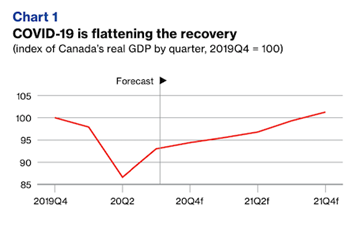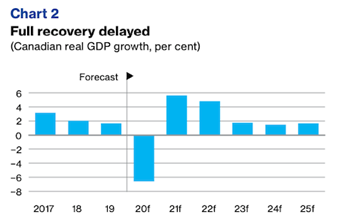Economic recovery will stall in the winter: Conference Board
Don’t expect Canada’s economic recovery to continue through the end of the year.
 While the country’s economy made good progress coming back from the government-enforced shutdowns mandated in March and April, the Conference Board of Canada suggests in its latest briefing that those good times may be behind us. Colder weather and suggestions that the second wave of COVID has arrived will stall the recovery, if not turn growth in the opposite direction.
While the country’s economy made good progress coming back from the government-enforced shutdowns mandated in March and April, the Conference Board of Canada suggests in its latest briefing that those good times may be behind us. Colder weather and suggestions that the second wave of COVID has arrived will stall the recovery, if not turn growth in the opposite direction.
“Progress has been made,” says Pedro Antunes, chief economist at The Conference Board of Canada. “But we nevertheless expect that localized closures and a retrenchment in some segments of household spending and business activity will hold back Canada’s pandemic recovery into the middle of next year.”
The impact of COVID-19 on Canada’s economy was swift and severe. At its trough in April, real GDP was at 82 percent of February’s pre-COVID levels, three million Canadians were out of work, and total hours worked had dropped by 28 percent.
As health restrictions began lifting in May, the rebound began. Statistics Canada estimates that July’s economic activity was at 94 percent of February levels, and by August, 1.9 million jobs had been recovered. The Conference Board calls that rebound “positive”, while adding that “a gaping chasm remains to be closed before Canada’s economy returns to normal.”
While a number of industries are back to full capacity, many won’t be until a vaccine is found and widely distributed. Some may never fully recover. Air transportation, for example, is operating at just 5 percent of normal levels. Accommodation, food and beverage services, textiles, manufacturing, printing, motion pictures and sound recordings all remain hard hit and face an uncertain future.
The Conference Board is optimistic a second full shutdown of economic activity can be avoided. It adds, however, that localized and regional shutdowns may be likely, and will certainly affect the economy’s path to full recovery.
 Overall, the Conference Board of Canada forecasts that real GDP will shrink by 6.6 percent in 2020. While significant, that is an improvement over the last Canadian Outlook that called for an 8.2 percent decline this year.
Overall, the Conference Board of Canada forecasts that real GDP will shrink by 6.6 percent in 2020. While significant, that is an improvement over the last Canadian Outlook that called for an 8.2 percent decline this year.
The board adds that over the medium term, provincial and federal governments will struggle to rein in spending, while rising interest rates will dampen gains in business investment and household spending. Canada’s unemployment rate is not expected to return to pre-COVID levels until 2025.
The board also expects growth in federal government consumption to slow to an average annual rate of 0.8 per cent between 2021 and 2025.








